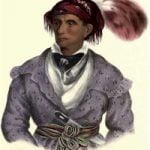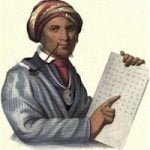
Why a white savage should do such a thing to a red savage is not so strange, but that a fairly educated man of some standing should be capable of such comment is hideously illuminating to those who seek true pictures of the 18th century border life.
Some of the Cherokees continued to fight the colonies until the close of the Revolution, but the main body succumbed after the first disaster and surrendered to the adjoining States a great part of their territory.
The first treaty with the new government of the United States was concluded in 1785. All of the Cherokee lands east of the Blue Ridge, and much of the northern boundary, were ceded to the whites. But the ink was hardly dry on the parchment before there began a conflict between State and Federal authority as to the remaining Indian land. Intruders swarmed into it. The Indians protested in vain. Bloody forays and reprisals were followed by open war in 1792.
Six years later another peace treaty was concluded, with more cessions of land, and with the usual guarantee on the part of the United States that thereafter the Cherokees should be left in possession of their country forever.
The retirement of the British to Canada, and the abandonment by Spain of claims east of the Mississippi, left both the northern and the southern tribes without any foreign backing; but the second war with Great Britain gave them a fresh opportunity. The Shawnee chief, Tecumseh, whose confederacy had been shattered at Tippecanoe, now rallied his forces and made common cause with England in the north. The Creeks in the south took to the warpath in 1813.
In this contest the Cherokees sided with the Americans. It was largely due to their help that General Andrew Jackson won a final victory over the Creeks at the Horseshoe Bend (Tohopeka), as a result of which most of the Creek territory passed over to the United States. how Jackson requited their aid will be seen in the sequel.
At the opening of the 19th century, the Cherokees had recovered from the ravages of war and were making rapid progress in the arts of peace. Their number had increased to about 20,000. Their fields and orchards were well cared for and prolific. Nearly every Indian had two or more horses, some of them owned cattle, and there was an abundance of hogs and poultry. The Federal government was encouraging industry by introducing plows and spinning wheels and looms.
There were some able men in the Nation, educated and quite as fit to lead or represent their people as the officers or politicians of the neighboring whites. Many were of mixed blood, descended in part from resident traders of the pre-Revolutionary period. These were not shiftless adventurers of “squaw-man” type but more like the Hudson Bay factors, men of good stock and character, who married regularly into the tribe and sent their children away to be educated or brought in private teachers from outside.
Such were the Daugherrys and the Adairs, the Rosses and the Woffords. Nancy Ward, a woman of great influence who was friendly to the Americans, was the daughter of a British officer by the sister of Atakullakulla, principal chief of the Cherokee Nation. General Samuel Houston, it may be remembered, took for his second wife the daughter of a Cherokee chief.
The Cherokees still remained in recognized possession of a region as large as Ohio, about half of it being within the present limits of Tennessee, and the rest in Georgia, Alabama, and the southwest corner of North Carolina. This is marked on the old maps “Cherokee Country” or “Cherokee Nation,” the United States claiming no jurisdiction over it.
If the Indians had nothing but the Federal government to deal with they might perhaps have secured just treatment. President Jefferson acknowledged their title and sovereignty within the limits fixed by treaty. It was a region very desirable for the future expansion of the whites, and coveted by them, but to which they had neither legal nor moral right.
It had been guaranteed to the Indians in perpetuity by the Government.
But our own Union in those days was loosely knit. The boundaries of those States bordering on the Cherokee country had been run without regard for Indian claims. Georgia, which then included all of what are now Alabama and Mississippi, claimed everything within its chartered limits, under the doctrine of State sovereignty, regardless of treaties negotiated by the Federal government.
Among the Cherokees themselves there was a disturbing element—a conservative, irreconcilable group that disdained civilization and dreamed of a free hunting ground far away where they should never be molested by the whites.
Taking advantage of this split between Indian factions, our Government then sought to compromise by proposing that the conservative Cherokees cede their proportionate share of land in return for a tract in the West, where they could enjoy the unfettered life of hunters and follow their primitive ancient ways. A treaty was negotiated, not with the Cherokee Nation but with a few chiefs of these malcontents, whereby considerable areas in Georgia and Tennessee were given in exchange for a western reservation, to which some of the Indians emigrated.
The main body of the Cherokees bitterly protested that this treaty had been effected by improper means and influences, without authority of their Nation, and could only be regarded as another move toward driving them from the land of their fathers. They pointed to the evidences of their own progress in civilization and begged that they be not forced to abandon this hard-won status and exiled to a wild land where stress of environment, and the hostility of native western tribes, would tend to make them revert to savagery.
Their pleas fell on deaf ears. Still another treaty was virtually thrust upon them by which they lost more than one-fourth of their territory, and this was declared to be a “final adjustment” of all claims and differences.
In the face of such discouragements, or perhaps stimulated by them, the Cherokees now made extraordinary efforts to win recognition as a civilized and independent people. In 1820, at the suggestion of Thomas Jefferson, they formed a republican government modeled after that of the United States, and seven years later they adopted a constitution.
This was an assumption of distinct nationality, and their sovereignty was recognized by the United States. They passed laws for the collection of taxes, for repairs on roads, for the support of schools, for the suppression of intemperance and polygamy, and for preventing the sale of lands to the whites without the consent of the national council.
And now occurred among these Indians, from within, an astounding development of culture which for originality and swiftness of accomplishment has no precedent nor parallel in the history of the human race.
There was a Cherokee of mixed blood named Sequoya (Se-quah-yah) who through an accident in hunting had become a cripple for life. Being unable to follow the chase, he took to sedentary occupations and developed considerable mechanical skill, especially in silver-working. He never learned to speak English, and of course could neither read nor write.

Inventor of the Cherokee Alphabet
Sequoya had observed that the whites had a way of “talking on paper” whereby messages were sent and records were preserved. It set him to brooding over a project for devising a similar system for his own people. Being an old-fashioned Indian true to his own religion, he did not seek help from the missionaries, and they in turn discouraged him. But by himself he pondered long and earnestly over the mystery of the talking paper.
Like every other inventor of writing he began by trying to make a separate symbol for every word or idea. This proved an utterly hopeless scheme. In Cherokee there were thousands and tens of thousands of words. Even if so many symbols were designed, yet no man could remember half of them.
After years of hard study, in the face of ridicule and repeated failures, Sequoya finally began analyzing his language into its component sounds. He had no conception of vowels and consonants, but he picked out the distinct syllables of his mother tongue and found there were only one hundred and fifteen.
Then came the brilliant solution of his problem; he would assign a separate character to each syllable, and any word in the Cherokee language could be written. For example, kalanu (raven) would be expressed by three symbols standing respectively for ka, Ia, and nu.
From an old spelling book he took the English alphabet and numerals, without the least idea of their sound or significance, and finding there were not enough characters for his purpose he devised others of his own. Most of the double consonants in Cherokee being formed with the hissing sound of s, he made a separate mark for it (when used as the initial of a syllable) and so reduced his syllabary to eighty-five characters. The mark for s and the one for the nasal u (like the un in hung) are the only actual letters in his system, as the vowel characters are used only when they form separate syllables.
The effect of this invention was amazing. Any one who could speak Cherokee, having once learned the sight and sound of these eighty-five marks, could at once read and write the language with precision. There was no arbitrary spelling to learn. Any Indian could pick up in a few weeks what it takes our own children at least two years of hard work to acquire. A bright child or adult could master the art of reading and writing in a few days.
As if by magic the education of the Cherokees became an accomplished fact. Through this invention of an illiterate, thousands of them became literate, without one school being established or one teacher hired.
Although Sequoya himself was a pagan, and remained so to the end of his days, the first literary fruit of his writing system was a translation of a part of St. John’s gospel, made by a native convert.
In 1827, the Cherokee Council resolved to establish a national newspaper in their own language. Types for that purpose were cast in Boston. The press, types, and paper were laboriously transported to the capital at New Echota. The type cases and other furniture were made on the spot, an office was set up in a log hut and thus began publication of the Cherokee Phoenix, under the editorship of Elias Boudinot, a young Indian who had been educated in Connecticut by the American Board of Commissioners for Foreign Missions.
Meantime the formation by the Cherokees of a national government caused a rupture between the Federal and State authorities. President Monroe approved the suggestion of the Indian agent that the Cherokee lands be allotted, the surplus sold for their benefit, and the Indians invested with full rights of citizenship in the States where they resided. But Tennessee, North Carolina, and Georgia refused to allow any Indians to live within their boundaries on any pretext whatever. Georgia further demanded cession of all Indian lands within the limits of her charter.

Trying to confirm the name “Honeycutt” is on the Cherokee rolls
Can you check name ” Honeycutt” to be on Cherokee rolls.
My mom stayed on the Cherokee res during summers when she was young shes now in her 60s shes atleast half do to her mom being full Cherokee she was not treated well for being a half breed so I have lost all knowledge of my heritage I’m not sure my grandmothers name would my mom be on a roll or list
I am trying to find out if Martha Jane Panther, daughter of John and Mary Panther is on any of the Cherokee Rolls.